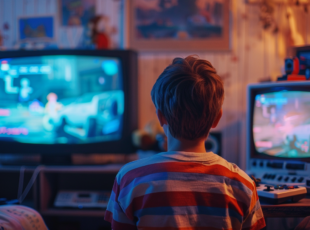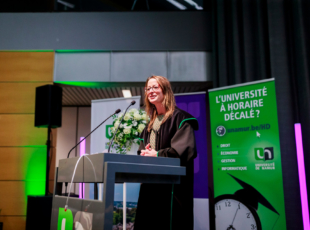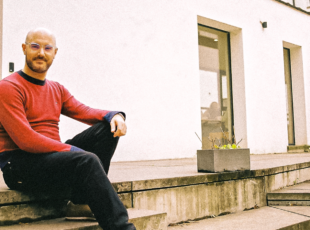Generative AI: a conversation with people who sell their prompts for a few Euros

Article author :
On the internet, some passionate devotees of technology, dubbed prompt engineers, specialise in the writing of prompts, the commands which are written to generate text (ChatGPT) or images (DALL-e, Midjourney, Stable Diffusion, etc.). Concurrently, new marketplaces where these prized commands can be sold are opening up. But who are these people who sell their words for a few Euros? Two of them report back to us.
Antique photographs, geometrical animals, colouring-in pages of Easter eggs … for just a few Euros, on Promptbase, you can get access to everything you need to produce these images yourselves on generative AI platforms. The one preferred by Elyam, who goes by the name of @riokarma on Promptbase, is a prompt to produce ‘incredible and memorable’ logos. ‘I am constantly astounded to see what people are able to produce with it,’ he says. A classical pianist aged thirty and based in Switzerland, Elyam is first and foremost a tech devotee. ‘I follow all the latest advances in the AI world because I find it fascinating and transformational.’ He contributes in a flash to beta versions of various tools and ‘loves the experimentation aspect.’ The same is true for Imagineer, a 40-year-old biomedical engineer based in Madrid, who prefers to remain anonymous. When he discovered these AIs, ‘capable of creating astonishing images on the basis of simple words,’ for him ‘it was like stumbling upon a magic lamp,’ he tells us.

A magic lamp, yes, but provided you know the magic words. And it is here that this prompt engineer makes his expertise count. An avowed partisan of ‘the power of social learning,’ Imagineer created a group, Télégram, dedicated to Midjourney. ‘Many people asked me how to obtain certain images. I saw their questions as little challenges which gave me the opportunity to explore this tool’s full potential. As I continued to practice and as I learned, I began to get better results with Midjourney than the majority of the community members.’ He sees this activity as being akin to learning a new language, he explains. ‘I would say that it involves the work of translation. In the case of generating images, my task consists of translating the image the client wants into a set of words, or a prompt, which the AI can understand and on the basis of which it can generate results coherently.’
For Midjourney, ‘traveller’ is more coherent than ‘backpacker’
On this the two experts concur: the key element of a good prompt is its coherence and therefore its reproducibility. ‘If a prompt is too general, it can produce results of variable quality, which makes it less predictable and more difficult to use,’ explains Elyam. On the basis of the same command, the buyers must be able to obtain similar results which can also produce different versions by changing a few words only.

And, most importantly, you need to know your tool. ‘Depending on the AI I am working with, I need to use specific words, avoid certain terms, and put them in the right order,’ Imagineer explains. ‘For example, for Midjourney, the term “traveller” is better suited than the term “backpacker,” if you want a person with a rucksack to appear in the image. It’s like completing a little jigsaw puzzle, and as I carry on writing prompts, I understand more about how the AI processes the instructions and what needs to be done to gain better results.’ For his part, Elyam considers that ‘as far as using AI for artistic purposes is concerned, it is a huge advantage to be very knowledgeable about art, artists, designers, photographers, painters, etc. This knowledge can help you make your request more specific or to describe a particular technique to the model with greater accuracy. For example, if you specify an aperture of f/1.8 at the end of your message, the model will know that a blurred background must be created. If you don’t know this photographic technique your command will be less effective.’
You have to recognise your limitations as well. ‘It is important to know if certain images can be produced or not to avoid wasting time,’ explains Imagineer. ‘At the end of the day, the models we use are in a kind of way a camera obscura, and you always have to progress by trial and error to obtain the best results,’ specifies Elyam.
600 Euros per month for one hour of work per week
And so, being a prompt engineer, is it a good job? ‘Much as I love acting the mad scientist with generative AI, I cannot really pay my rent with a handful of prompts,’ jokes the pianist. Ranked seventeenth on the platform – at his peak he was No. 2, he says, rather proudly – he doesn’t do too badly, however. Since registering in August 2022, he has sold 723 prompts for a total of 2,000 dollars. Ranked No.9, Imagineer also does pretty well for himself: on the platform he earns around 600 dollars per month by spending one hour each week creating content. ‘Some of my colleagues are a lot more active and can easily make 100 dollars a day,’ he declares.



The identity of their clients remains a bit of a grey area. ‘It’s a diverse group of people,’ Elyam informs us. ‘The curious who want to try out generative AI, early adopters of technology, entrepreneurs looking for ideas for their logos, or graphic artists seeking inspiration for their work. I am always curious to see whom my messages resonate with and how they are used, but for most of the time it’s a bit of a mystery.’ Imagineer, who sometimes guides his clients through customised prompts which can be worth up to 190 dollars, has a slightly clearer idea. ‘They are users who are looking for a specific type of image, such as a nice illustration for a children’s book, but who don’t want to waste time experimenting. They prefer to pay a few dollars to have the opportunity of creating endless images or illustrations with a definite style. I work with all the people who need to create unique images, such as interior decorators, online T-shirt boutiques, corporate marketing specialists, blog illustrators or video game designers,’ he states.
As regards the future of their occupation, the two prompt engineers are aware that in a sector in which everything happens so quickly, knowing how to adapt will be vital. ‘It is possible that in a few months a new AI will appear, rendering prompt engineers obsolete. Staying adaptable and learning quickly is thus essential, in order to be ready to get to grips with the new wave of technological advances,’ warns Imagineer. But without forgetting to remain optimistic, for Elyam. ‘The prompt engineering will still have a role to play in the future of generative AI. As the technology becomes more powerful and sophisticated, it will free human imagination in new and fascinating ways. Prompt engineering can be seen as a way of pushing beyond the boundaries and inspiring new forms of creativity.’ Revolutionising creativity, one word after another.
A story, projects or an idea to share?
Suggest your content on kingkong.
also discover

Three days at the Wallifornia MusicTech Summit, in the “Cité Ardente”

When the video game (over)does nostalgia

Amélie Lachapelle: ‘the digital transition will have to be green or it will not take place’


